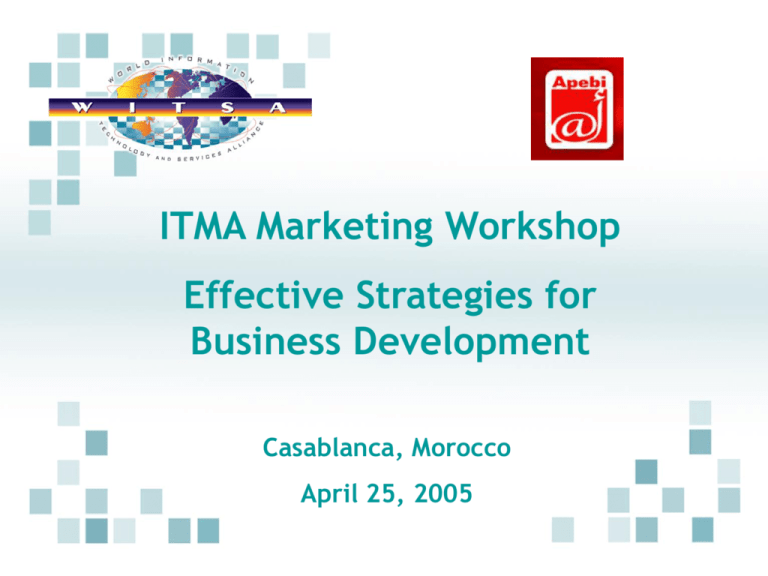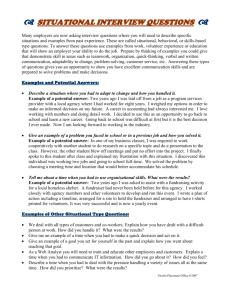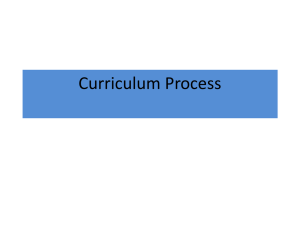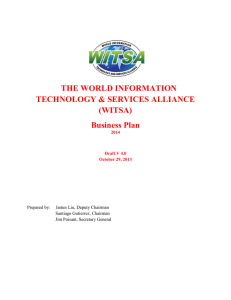Document
advertisement

ITMA Marketing Workshop Effective Strategies for Business Development Casablanca, Morocco April 25, 2005 AGENDA Part One: Setting the Stage Part Two: Strategic Communications Part Three: Effective Marketing Part Four: Ensuring Customer Satisfaction April 25, 2005 2 PART ONE: SETTING THE STAGE THE SITUATIONAL ANALYSIS Allen Miller WITSA Executive Director THE SITUATIONAL ANALYSIS •Macroenvironment •Market •Competition •Product •SWOT April 25, 2005 4 THE SITUATIONAL ANALYSIS – Macroenvironmental Situation Define and analyze: •Economy •Technology •Political/legal •Social/cultural trends – education, lifestyle changes April 25, 2005 5 THE SITUATIONAL ANALYSIS YOUR ICT MARKET •Domestic vs. International Markets •Market characteristics •Market size: ICT spending and growth •Buying-behavior trends •Contracting environment April 25, 2005 6 THE SITUATIONAL ANALYSIS – Market How to appropriately identify your target market: •Demographic descriptors – firm information, attributes of individual customers •Geographic descriptors – define trade area •Behavioral descriptors – benefits sought by the customer, usage rates, lifestyle April 25, 2005 7 THE SITUATIONAL ANALYSIS – KNOW YOUR CUSTOMER Develop a customer profile: •Analyze business climate •Commercial sector trends •Government outsourcing trends •Identify primary decision-makers •Know your customer’s customer April 25, 2005 8 CUSTOMER PROFILE FRAMEWORK WHO – company, decision-makers, contact information WHAT – industry and sector, product line WHEN – product/service delivery and implementation WHERE – geographical location of company and their customers WHY – their needs and your added value HOW – marketing channels that will reach the customer April 25, 2005 9 THE SITUATIONAL ANALYSIS – Competition •Develop a competitor profile: customer base, products or services, revenues, marketing strategies? •Sources for information: marketing materials, employee and customer networks, news releases, prior knowledge •Continually monitor competitive landscape on a periodic basis April 25, 2005 10 THE SITUATIONAL ANALYSIS – KNOW WHAT YOU ARE SELLING •Determine and prioritize customer needs •Identify the benefits of your products/services in meeting customer needs •Know where your products/services rank in the competitive landscape April 25, 2005 11 EXERCISE: SWOT ANALYSIS Conduct a SWOT analysis that identifies your company’s internal strengths (S) and weaknesses (W) from the perspective of the products/services offered and examines external opportunities (O) and threats(T) April 25, 2005 12 PART TWO: STRATEGIC COMMUNICATIONS Cindy Hwang WITSA Marketing Director April 25, 2005 13 COMMUNICATIONS OBJECTIVES – Your Brand •What do you want the customer to know? •What do you want the customer to do as a result of the acquired knowledge? April 25, 2005 14 MARKETING MIX Specify goals and objectives for the 4Ps: •Product/Service •Place/Distribution •Promotion •Price April 25, 2005 15 KEY MESSAGES •Use clear, concise, and compelling language •Identify your deliverables •State the derived benefits •Be persuasive April 25, 2005 16 MARKETING TOOLS •Identify effective media channels •Newspapers and magazines •Radio •Internet •Identify effective promotional tools •Examples of marketing collateral April 25, 2005 17 EXAMPLES April 25, 2005 18 EXAMPLES April 25, 2005 19 EXAMPLES April 25, 2005 20 WEBSITE LAYOUT April 25, 2005 21 EXERCISE: THE ELEVATOR SPEECH Craft an elevator speech that explains your company, differentiates your products/services from competitors, and showcases your strengths in meeting customer’s needs. April 25, 2005 22 PART THREE: EFFECTIVE MARKETING Tom Chesney Computer Frontiers April 25, 2005 23 Promoting Your Company Taking Company Image to Personal Level •Importance of Personal Relationships •Strategic use of Founder/President •Showcasing Talents of Company Team April 25, 2005 24 Strategic Use of Founder/President April 25, 2005 25 Showcasing Your Company’s Resources Identifying Options for Developing Trust While Demonstrating Corporate Assets •Software/Hardware Demonstrations •Visit to Site Installation •Presentations to Reinforce Key Messages •Case Studies April 25, 2005 26 Creating a Vision Engage the Customer in a dialogue on: •The Customer’s Business Needs •How Company Will Help Meet Customer Needs •Critical Success Factors •Performance Metrics •Competitive Advantages April 25, 2005 27 PART FOUR: ENSURING CUSTOMER SATISFACTION April 25, 2005 28 STAFFING CONTINUITY •Plan for maintaining talent on the sales and delivery teams •Prepare for future transition issues April 25, 2005 29 ONGOING COMMUNICATIONS •Plan for regular communications •One-way and two-way dialogue •Follow-up phone calls or emails •Establish an ongoing relationship April 25, 2005 30 REGULAR PERFORMANCE METRICS •Customer surveys •Feedback •Satisfaction surveys •Evaluation surveys •Cisco’s customer satisfaction survey April 25, 2005 31 PERFORMANCE METRICS – THE CISCO EXAMPLE “The Annual Customer Satisfaction Survey is conducted via the Internet and lets us collect feedback from customers worldwide. Results are made available to all Cisco employees to foster quality improvement and to provide a point of reference where we may need to employ resources more productively.” April 25, 2005 32 TECHNOLOGY REFRESHMENT •Outline plans for introducing new technologies •Thought leadership in deploying in the latest technologies •Smooth conversions from old to new April 25, 2005 33 Thank You Merci! Allen Miller – amiller@itaa.org Cindy Hwang – chwang@itaa.org Tom Chesney – tchesney@computer-frontiers.com April 25, 2005 34







